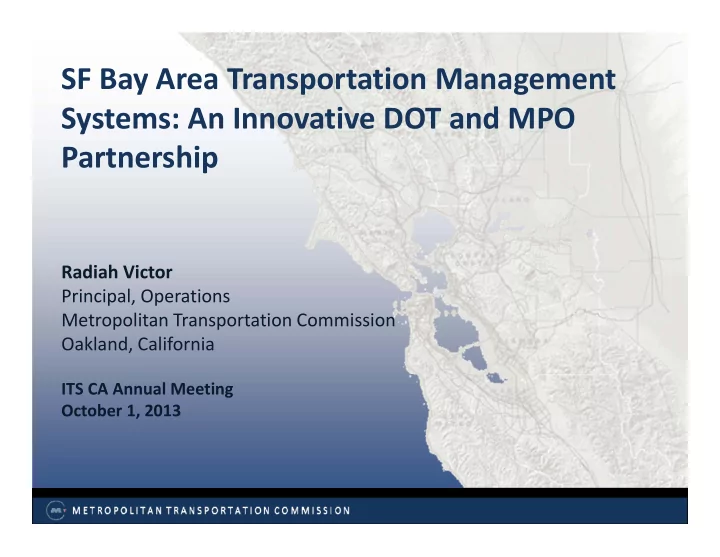

SF Bay Area Transportation Management Systems: An Innovative DOT and MPO Partnership Radiah Victor Principal, Operations Metropolitan Transportation Commission Oakland, California ITS CA Annual Meeting October 1, 2013
Outline 1. Overview of Bay Area Infrastructure 2. Regional Challenges Condition of Highway Infrastructure Constrained Funding & Staff Resources 3. Transportation Management Systems Field Equipment Performance 4. Future Efforts/TMS Vision 5. Innovative Partnership with Caltrans District 4 2
San Francisco Bay Area Overview Seven million residents 2 nd most congested region in US. More than 4.6 million cars 20,000 miles of local streets and roads 1,420 miles of highway 450 miles of carpool lanes 8 toll bridges 28+ transit agencies Extensive ITS infrastructure 3
SF Bay Area State Highway ITS Infrastructure 2,500 traffic detection stations 140 changeable message signs 390 cameras (traffic monitoring & incident management) 380 ramp metering systems Regional TMC Call boxes, Freeway Service Patrol, 511 traveler information Express Lanes & Integrated Corridor Management 4
Performance: Freeway Sensors • Statewide sensors reliability goal: 70% Suspected Errors • For the past year, only ~50% of sensors installed in the roadway have been functional Card Off (70 %) Ctlr Down ( 22 %) High Value (5 %) Other Errors (3 %) Sept. 2012 Sept. 2011 5
Regional Challenges: Constrained Funding & Staff Resources • “…dealing with preservation shortfalls has an exponential fiscal impact (the less you do today, the more it will cost you tomorrow).” Caltrans Program Review—July 2012. 6
Transportation Management System 7
Current Field Equipment Operational Status Percent Operational 100% Ramp Meters 93% 90% 84% 80% CMS 70% Traffic Detection 60% 58% Stations 50% 48% CCTV Cameras 40% 30% 20% 10% 0% 1/11 1/18 1/25 2/1 2/8 2/15 2/22 3/1 3/8 3/15 3/22 3/29 4/5 4/12 4/19 4/26 5/3 5/10 5/17 5/24 5/31 6/7 6/14 6/21 6/28 7/5 7/12 7/19 7/26 8
Field Equipment Operational Trends CMS Repaired vs. Newly Failed Ramp Meters Repaired vs. Newly Failed 60 70 60 50 50 40 Cumulative fixed Cumulative fixed 40 30 30 Cumulative new Cumulative new 20 failures 20 failures 10 10 0 0 1/11 1/25 2/8 2/22 3/8 3/22 4/5 4/19 5/3 1/11 1/25 2/8 2/22 3/8 3/22 4/5 4/19 5/3 Detection Repaired vs. Newly Failed CCTV Cameras Repaired vs. Newly Failed 700 40 35 600 30 500 25 Cumulative fixed Cumulative fixed 400 20 300 Cumulative new 15 Cumulative new failures failures 200 10 100 5 0 0 1/11 1/25 2/8 2/22 3/8 3/22 4/5 4/19 5/3 1/11 1/25 2/8 2/22 3/8 3/22 4/5 4/19 5/3 9
Regional Investment Strategy Transportation 2035 ($1.3B) Plan Bay Area ($2.7B) Arterial Arterial Management Management 5% 2% ($150M) ($30M) Field Equipment 19% ($514M) TMS Field Maintenance Incident Operations Equipment and Management 37% 46% Replacement 13% ($1,000M) ($600M) 48% ($365M) ($625M) TMS Maintenance and Replacement 26% ($700M) 10
TMS Governance Principles Performance Define performance targets to optimize operations. Achieve TMS operational benefits across multiple systems and programs. Decision Making Adopt a performance management approach. Streamline TMS decision ‐ making and prioritization. Ensure accountability and transparency. Secure a management stake. Resources Strategically manage the system within the resources available. Leverage regional contribution to secure funding commitment from state. 11
Shared TMS Vision A regional, integrated Bay Area freeway network that provides a safe and reliable travel experience for the region’s travelers. To achieve this we will: Actively manage our network infrastructure and assets; Be responsive to our customers’ need for a consistent travel experience across the region; Place a high priority on the safety and security needs of our travelers and network infrastructure investments; and Utilize our fiscal and staff resources in a manner that is effective and fiscally responsible. 12
Innovative Partnership with Caltrans D4 Moving towards a performance ‐ based TMS Shared Goal program Sample TMS Performance Targets TMS Field Equipment Sample Performance Targets High Priority Second Priority Assets Assets Changeable Messages Signs 95% 80% Ramp Metering 95% 80% CCTV Cameras 95% 80% Traffic Monitoring Systems 70% 60% 13
TMS Strategic Planning Efforts Underway to Support Active Traffic Management 14
Contact: Radiah Victor rvictor@mtc.ca.gov www.mtc.ca.gov 15
TMS Needs Assessment Assessment is underway to identify common field equipment issues and resolution strategies: Copper wire theft Software repairs Equipment failure rates Trend analysis Analysis of the type, frequency and cost of repairs will inform future resource requests 16
Performance: CCTV Cameras Upgraded 390 CCTV cameras 186 are operational Communication infrastructure needs investment Communication % of Cameras Reliability Infrastructure ISDN 93% Poor DSL 3% Good Fiber 2% Excellent T ‐ 1 1% Good Wireless 1% Fair 17
Performance: Ramp Metering To be expanded from 380 locations (40% of system) to 500 locations (53% of the system) by 2015 18
Performance: Changeable Message Signs • 140 CMS ‐ 33 with Travel Times • Caltrans calculates the CMS travel times • 511 conducts performance monitoring of CMS travel times • Due to advances in technology, 511 uses GPS probe ‐ based data, provided by INRIX, at lower cost and greater coverage 19
Recommend
More recommend